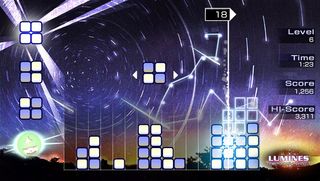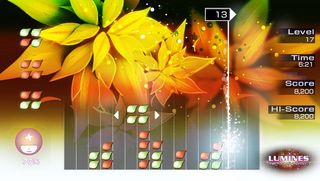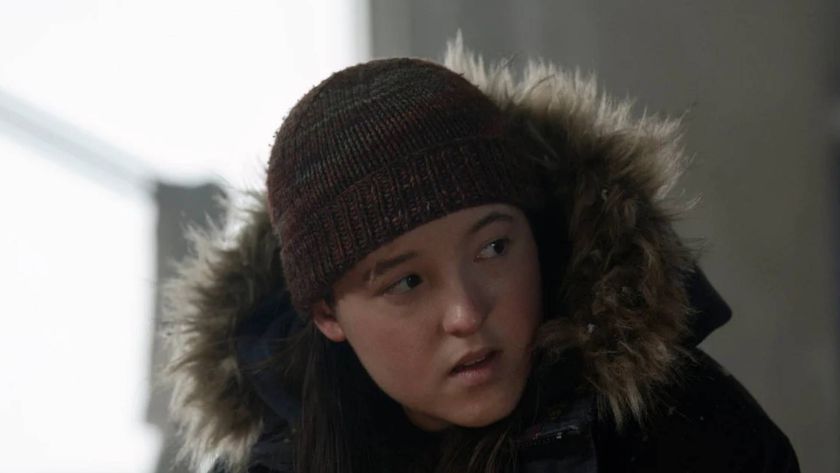12DOVE Verdict
Pros
- +
New skins that tease your brain
- +
Subtle features that deeply affects your tactics
- +
Amazing soundtrack
Cons
- -
Taxing your brain for things to hate
- -
Missing your bus stop while playing
- -
Yourself
- -
if you skip out on it
Why you can trust 12DOVE
Q? Entertainment’s pedigree when it comes to the synthesis of electronic music and lush aesthetic splendor is world-renowned. From Rez to Child of Eden, Q?’s titles are, if nothing else, visually arresting and unique experiences. Yet, among the developer’s numerous games, few have gripped gamers like Lumines. It was the arguably strongest reason to pick up a PSP in the handheld’s first year--and frankly, years later, it’s among the few games anyone consistently revisited. It’s apropos, then, that after a cooling period, the series returns with Lumines: Electronic Symphony, a sequel that recaptures the sensation, wonder, and bliss of its predecessor.
Electronic Symphony advances the Lumines formula with some clever riffs on the game’s well-established tropes. The core concept—stacking similar-colored blocks and waiting for a sweeping laser to clear your progress as a series of soundtracks and contrasting motifs blend in—is very much intact, but the new gameplay elements make this feel like a sequel in the sense that the 2006 numerical follow-up and copious reiterations weren’t.

With the addition of new block types, Electronic Symphony challenges your idea of how the experience should roll out. Aside from blocks that chain together one specific color, you’ll play with blocks that completely switch the color back and forth. At surface level, it’s a fun dynamic that toys with your idea of block placement, but in the later stages as the tempo ramps up, it makes the difference between survival and starting over. And fortunately, if you fail, you won’t have to start all the way at the beginning of the game to unlock more skins, which rewards and respects your time investment more than in past iterations.
Also, in past game, your character selection was more about personalizing yourself. In Electronic Symphony, your character also comes with perks. They affect your progress with “get out of jail free cards” that give you abilities such as switch blocks and pausing the time sweep. You’ll also be able to use these talents as weapons in multiplayer. Again, these additions seem minor, but ultimately transform the dynamics of how you approach Lumines’ now-familiar formula.
We’ve seen some successful and less-than-successful attempts to capitalize on the Vita’s hardware capabilities in this launch window, and while some titles revel in the ability to showcase what the machine can do, Electronic Symphony’s “less touch is more” approach works wonderfully. You can tap the touch screen to rotate blocks, but it’s not a requirement. A quick tap in the lower left corner will allow you to unleash your perks, and that’s really all the game needs. You can get more hands-on, but the game doesn’t demand it of you.
One can’t understate just how beautiful the game looks, either. We’ve seen Lumines in HD on consoles, but the skins and art choices accentuate the Vita exceptionally well. The shapes and background designs not only showcase the high resolution screen, they also toy with your brain in ways unseen in prior games, from depth perception to color palates. There's a standard that one expects from the games, and Electronic Symphony exceeds it.

And, of course, a Lumines game is equally defined by its soundtrack as it is by its look. Q? has pulled out all of the stops for Electronic Symphony. From classics like The Chemical Brothers’ “Hey Boy, Hey Girl,” Aphex Twin’s “Windowlicker,” and Josh Wink’s “Higher State of Consciousness” to contemporary dance music superstars like Kaskade, it wonderfully melds beats and tempos to dazzling skins and shapes to create a pacing to puzzle solving that ebbs and flows with the energy of a DJ mix, complete with heat-ups and cooldowns.
Lumines has seen several iterations in the seven years between PSP’s launch and PlayStation Vita’s debut, almost to the point of fatigue. Yet, for the more pop-influenced variations and its omnipresence on multiple platforms, the charm of its core mechanics always shone through. With Lumines: Electronic Symphony, the series grows and expands in ways that render prior games as more spin-offs than true sequels. It reinvents itself for a new medium and showcases Sony’s new handheld, just as its predecessor managed in 2005. Mark our words: you will remember why you loved this game so much.
More info
| Genre | Puzzle |
| Description | Lumines has seen several iterations in the seven years between PSPs launch and PlayStation Vitas debut, almost to the point of fatigue. Yet, for the more pop-influenced variations and its omnipresence on multiple platforms, the charm of its core mechanics always shone through. |
| Franchise name | Lumines |
| UK franchise name | Lumines |
| Platform | "PS Vita" |
| US censor rating | "Everyone" |
| UK censor rating | "" |
| Alternative names | "Lumines Vita" |

"30 years of history reside in our tape backups": PlayStation's building a game preservation mineshaft vault with 200 million files going back to a 1994 build of PS1 JRPG Arc the Lad

The other big Soulslike out this week has some Bloodborne and Dark Souls 3 in its combat, dev says, but "we would rather call AI Limit an action RPG"

The Last of Us showrunner says "so much" has happened in the five-year gap since we last saw Joel and Ellie: "That's part of the mystery of the season"











